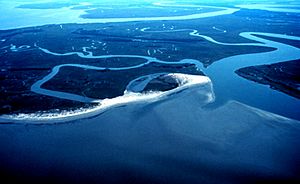Ashepoo Combahee Edisto Basin National Estuarine Research Reserve facts for kids
The Ashepoo Combahee Edisto Basin National Estuarine Research Reserve (that's a mouthful, so we often call it the ACE Basin NERR) is a huge protected area in South Carolina. It covers about 140,000 acres (that's over 560 square kilometers!). This special place protects one of the biggest undeveloped estuaries on the Atlantic coast of the United States.
An estuary is where a river meets the sea. Here, the fresh water from rivers mixes with salty ocean water. The ACE Basin NERR gets its name from three rivers: the Ashepoo, Combahee, and Edisto River. These rivers flow through amazing landscapes like cypress swamps, old rice fields, and marshlands. They all meet at St. Helena Sound, which is super rich in different kinds of plants and animals.
Contents
Why is the ACE Basin NERR Important?
The main goal of the ACE Basin NERR is to protect this amazing natural environment. It also helps keep the wildlife and the area's history safe.
Protecting Endangered Animals
This reserve is a safe home for many animals that are rare or in danger. These include:
- The shortnose sturgeon, a unique fish.
- Wood storks, large wading birds.
- Loggerhead sea turtles, which lay their eggs on nearby beaches.
- And even bald eagles, the national bird of the U.S.!
A Place for Fishing and Fun
The ACE Basin is also a busy spot for people.
- Commercial fishing: Many people work here, catching shrimp, crab, oysters, clams, and different kinds of finfish. These are then sold to stores and restaurants.
- Recreational fishing: If you like to fish for fun, you can find fish like spottail bass and flounder in the mudflats.
- Paddling adventures: People also love to explore the salt marsh creeks and the dark, calm waters of the rivers by canoe or kayak.
Learning and Research at the Reserve
The ACE Basin NERR isn't just about protecting nature; it's also a place for learning and discovery.
Understanding the Ecosystem
Scientists at the reserve do important research. They:
- Check the water quality to make sure it's clean and healthy.
- Count and identify all the different plants and animals living there.
- Study the overall health of the ACE Basin ecosystem.
This research helps everyone understand how to best protect this special place for the future.
Educational Programs for Everyone
The reserve offers many programs to teach people about estuaries and why they are so valuable.
- They host summer talks for the public.
- They create learning materials for teachers to use in classrooms.
- They have a "touch tank" program where kids can safely touch and learn about marine creatures.
- They even offer boat trips where students and teachers can see the estuary up close and learn about its importance to sea life, birds, and humans.


